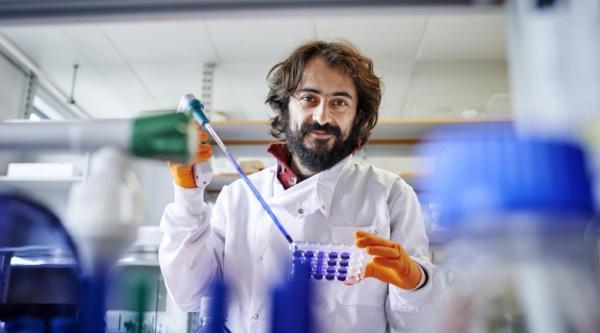From lab to laptop
From Care and Cure Magazine 2015, read about research into compounds in the blood.
Petroula Proitsi is in the third year of an Alzheimer's Society fellowship, investigating changes in compounds in the blood that are associated with Alzheimer's disease. Her cutting-edge approach will hopefully help us to understand the complex mechanisms that cause Alzheimer's, and lead to faster diagnosis and better treatments.
As an undergraduate I was fascinated by the release of the first draft of the Human Genome Project and the possibilities it opened up for the investigation and treatment of complex genetic disorders. After 11 years studying Alzheimer's disease, I am still motivated by this same fascination, and the desire to help make a difference in tackling this devastating illness.
A new approach
My PhD started in the lab, where I learned a range of genetics techniques. My project investigated the genetic basis of behavioural symptoms in Alzheimer's disease - not only looking for genes that increase the risk of developing Alzheimer's, but also those that increase the risk of specific symptoms frequently experienced by people with the condition, such as depression, psychosis and aggression.
What captured my imagination and interest was how the problem was so complex and multidimensional. I had a database with thousands of patients, each experiencing a different degree of behavioural symptoms, each with different histories as well as genetic profiles. It was obvious that making sense of this complexity would need a new approach, and my PhD began to move from the lab to the computer as I started using new techniques to tackle huge amounts of complex biological data.
Advancing information
In the decade that I have been working in the field of Alzheimer's disease I have witnessed rapid technological advances that have led to massive international studies providing unprecedented levels of biological detail.
The advent of large-scale studies and increasing collaboration has provided us with study groups that are rich with clinical and biological information. These have led to the discovery of many biological and environmental factors associated with Alzheimer's disease. However these advances have highlighted the complexity of this condition and the fact that information about many aspects of the disease is still missing.
Since being awarded my fellowship, I have worked on a number of different projects, tackling questions such as whether there is a common genetic basis between diabetes and Alzheimer's disease and whether high levels of fats in the bloodstream increase your risk of developing Alzheimer's. As someone with laboratory-based skills as well as statistical expertise I have been able to help my colleagues in different projects, leading to interesting collaborations.
Metabolites
As Alzheimer's disease causes damage to the brain long before symptoms appear, scientists have started to turn their attention to finding biological markers of the disease that may signal its onset.
The blood carries a lot of molecules that are the intermediate or final products of processes going on in different parts of the body, including the brain. These molecules are known as metabolites and there are hundreds or thousands of different types, including fats and vitamins. Changes in metabolites can indicate abnormalities in biological processes, and they are easy to measure and to track over time.
Recently, studies have demonstrated the promise of using blood metabolites as markers of Alzheimer's disease. We can say that they provide a molecular 'footprint' of the disease's progression and response to treatment. Additionally genes have been found to determine the levels of these metabolites.
This inspired my current Alzheimer's Society fellowship, where I am trying to identify differences in blood metabolites between people with Alzheimer's disease and people who do not have the condition. I hope to identify metabolites that can predict changes to the brain, and to investigate whether genetic differences are associated with changes in the metabolites among these groups.
Big data
Experiments to measure metabolites in the blood have identified more than 4,000 different molecules, many of which are very similar. It is therefore very challenging to summarise all this information and to identify a combination of metabolites that can predict if an individual has or will have Alzheimer's disease.
Associating these metabolites with other types of biological information is even more challenging. Large-scale genetic studies, for example, provide information on more than 9 million DNA changes. Such analyses require well-designed programs and very powerful computers.
They also require collaborations between scientists who work on different biological aspects of the same data, and large independent datasets for us to replicate our findings.
Finally, they also require patience, systematic analysis and strong vision. We know that this data contains a large amount of information and we have to make sense of it systematically by asking the right questions.
My aspiration is both to find molecules that can predict whether an individual will have Alzheimer's disease, and to understand what causes changes in the levels of these molecules.
Getting results
So far we have analysed data from over 400 people and we have found associations with certain molecules. For example, we found a set of 10 metabolites that are associated with Alzheimer's disease.
Although these results cannot yet be used to diagnose the condition, they point towards potentially important treatment targets. The processes affecting these metabolites might be altered through biological manipulation, pharmaceutical intervention or lifestyle changes.
This is a very exciting project at a very important moment in Alzheimer's disease research, as we have new tools to help to defeat it. I am thrilled that I have the opportunity to contribute to this cause and to be able to conduct exciting, ground-breaking science and I am grateful to Alzheimer's Society and all of the patients, volunteers and research monitors for their support.








